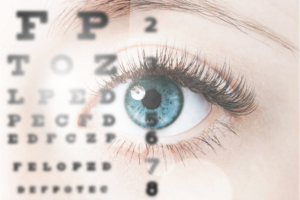If you spend long periods looking at your smartphone or working on a computer, you need to watch out for something called digital eye strain.
According to a 2015 survey by the American Optometric Association, 59% of adults have experienced symptoms of digital eye strain, or computer vision syndrome, as a direct result of spending several hours a day staring at a digital screen. Some of those symptoms include dry eyes, headaches, and blurred vision.
Top 10 Tips for Digital Eye Strain Relief
The best way to avoid digital eye strain is to cut down on daily digital distractions. But that is easier said than done. Fortunately, there are many ways you can take care of your eyes and relieve digital eye strain. Just follow these simple tips.
1. Take breaks regularly
Eye care professionals (ECPs) recommend following the 20-20-20 rule to avoid digital eye strain. The rule says that you should look at an object 20 feet away for 20 seconds every 20 minutes to relieve eye fatigue.
The following methods can help make following this rule easier:
- Set the alarm for every 20 minutes as a reminder to take a break.
- Look out a window during the 20-second breaks – focusing on a tree, a lamppost, or a building across the street should work well.
- Alternatively, try closing your eyes for 20 seconds every 20 minutes.
2. Blink more frequently

Blinking keeps the surface of our eyes moist to prevent dryness and irritation. However, we tend to blink less frequently when staring at a digital screen. During these non-blinking phases, tears coating the surface of our eyes evaporates more rapidly, causing dryness.
Try blinking ten times very slowly every 20 minutes to help moisten your eyes to minimize the chances of them becoming dry.
3. Exercise your eyes
Staring at a stationary object, such as your smartphone or your computer monitor, for long periods can strain the muscles that aim and focus your eyes. Therefore, it’s essential to exercise your eyes.
- To prevent eye strain while using digital devices:
- Try performing the focus change exercise.
- Start by holding one finger a few inches away from one eye.
- Focus your gaze on your finger, then slowly move your finger away from your face.
- Focus on an object farther away, then focus again on your finger.
- Bring your finger back closer to your eye, then focus on an object farther away.
- Repeat this exercise three times.

Another good exercise for digital eye strain is the figure-eight exercise. This exercise can help reduce tension and soreness in the muscles behind your eyes.
To perform this exercise, start by focusing on an area on the floor about eight feet away from you. Trace the number eight on the floor for eight seconds, then retrace the number in reverse.
You can do this exercise three to five times in a row every hour to relieve digital eye strain.
4. Use proper lighting

Lighting can also cause digital eye strain. It can either be too dim or too bright, depending on the activity. For instance, dimming the lights may help reduce eyestrain when watching television. But when using a computer, your ambient lighting should be about half as bright as that typically found in most offices.
Try to eliminate exterior lighting by closing shades or blinds. You can also reduce interior lighting by using fewer light bulbs or fluorescent tubes.
5. Reduce glare
Glare from light reflecting off bright walls and finished surfaces can also cause eye strain when using digital devices. To reduce glare, consider the following:
- Install an anti-glare screen on your device.
- Position your monitor perpendicular to windows to prevent direct glare.
- Paint bright white walls a darker color with a matte finish.
6. Adjust your device’s display settings
Adjust the following settings on your device to help reduce eye discomfort and fatigue:
- Brightness – Your screen should neither be too bright that it looks like a light source in the room nor too dim that you have to squint to read the text and see images.
- Text size – The letters on your screen should be about three times the smallest size you can read from 20 to 30 inches away.
- Contrast – Our eyes prefer black text on a white background for color combinations. Avoid low contrast text and background color schemes.
7. Use artificial tears

Artificial tears are specially formulated solutions that contain moisturizing agents. Also known as lubricant eye drops, they help relieve and prevent eye dryness caused by excessive screen time. Apply one to two drops of artificial tears on each eye every few hours.
You can buy artificial tears without a prescription. That said, it’s best to consult an ECP before purchasing this product. That way, the ECP can advise you on how best to use artificial tears to relieve and prevent digital eye strain.
8. Check the air
Dry or polluted air indoors may cause eye strain when using digital devices. Consider improving air quality by using a humidifier or adjusting your room’s heating and cooling system. If neither option is possible, try relocating to a spot that doesn’t have the same air issues.
9. Consider computer glasses

If work obligations prevent you from limiting your computer and smartphone use, consider computer glasses. As the name suggests, these prescription glasses are specifically made to reduce the eye strain associated with computer work.
Computer glasses work by reducing how much focusing your eyes must do when viewing digital screens. This is comforting for people of all ages, but it’s beneficial for people at risk for age-related vision problems.
Alternatively, consider contact lenses prescribed for computer work. Such contact lenses are made of a highly breathable material called silicone hydrogel. Silicone hydrogel contact lenses help keep your eyes comfortable when using digital devices for prolonged periods.
Whether you prefer glasses or contacts, be sure to consult your ECP to determine if you need special eyewear to prevent digital eye strain.
10. Get a comprehensive eye exam

A comprehensive eye exam is one of the most important things to prevent or treat vision problems caused by digital eye strain. Tell your ECP how often you use a computer and other digital devices at work and home during your exam.
If you regularly work on your computer, it would also help to measure how far your eyes are from the monitor when you sit in front of it. Bring this up with your ECP so that they can test your eyes at that specific distance.
Final Words
While spending less time using digital devices would be best, it’s not always realistic. Luckily, there are many ways to relieve digital eye strain caused by too much screen time. By following the digital eye strain relief tips above, you can take better care of your eyes, even when you’re using your devices.


